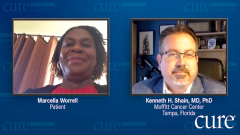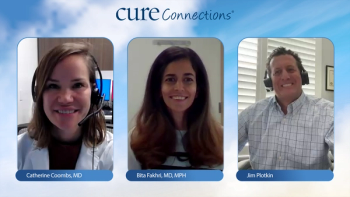
Learning How to Live With Multiple Myeloma
Taking her own experience with multiple myeloma into account, Marcella shares how she learned to live with the disease by practicing good health and communication habits.
Episodes in this series

Kenneth H. Shain, M.D., Ph.D.: You’ve been on this journey, and you’ve gone from a diagnosis brand new and having no idea what was going on. And even when you got good therapy, it worked, but it was tough. One of the things I always think about for patients, because I’m a physician and I never experience it, is how do you learn to live with myeloma?
Marcella Worrell: I try to eat healthier and exercise a lot. I call working in the post office, my mail truck, exercise because I’m in and out. That works for me. It’s mostly taking every day one day at a time and knowing yourself. At the airport, they tell you, “If you see something, say something.” I say, “If you feel something, say something.” That’s what I do. Every time I go to you or [Daniel] Spitz, [M.D., FACP,] if something doesn’t feel right, I tell him or you, and we talk about it. He’d send me for more tests to see what’s going on. That’s how I take it every day. It’s one day at a time and work with your doctors.
Kenneth H. Shain, M.D., Ph.D.: Good. You’ve also mentioned your son and sister a lot in this. This journey really involves a village, correct? Support is really important.
Marcella Worrell: Yes. My sister especially. She used to live in Texas, and she left there the very first day I called her crying after I found out what I was going through. I asked, “How am I going to handle this?” She called me and said, “Don’t worry.” The very next day, she was here taking care of my son while I was in the hospital. That’s how it was with my family. My church family stood around me. They were there as a crutch I could lean on. I relied on doctors. I had a lot of people who rallied around me. Don’t let yourself get into a state of depression. That could be the worst thing. At first, when I didn’t know, I would say I probably would have been going into depression. But once my sister said, “I’ll be here to take care of Jacoby,” that helped me so much. And she’s still here with me. She moved to Florida because she liked it so much. It’s having people around you who aren’t negative and won’t bring you down. Positive thinking is very important. That’s how I have made it through, with positive thinking and lots of prayers.
Kenneth H. Shain, M.D., Ph.D.: That’s fantastic. That’s a great message to send. If you were able to talk to somebody who was just diagnosed or relapsed today, that’s a great message. Is there anything else you would pass on to them about how you could use your experience to help them cope a little better and deal with it a little better? Because that’s a great story you just told.
Marcella Worrell: Yes. I would tell them to stay on top of it. If you need me, I will talk to you anytime. I’ve had a lot of people talking to me and telling me good things, and I wouldn’t mind being there for someone. I would love to share my story so they can know what I went though and help them along the way, which is a good thing. Most important of all is staying positive. Stay positive, know this too will pass, and move forward.
Kenneth H. Shain, M.D., Ph.D.: Most importantly, do you have any neuropathy right now?
Marcella Worrell: No, none. Thank you, God, none at all. I’m feeling so much better on what I’m doing right now. I thank Dr. Spitz all the time.
Kenneth H. Shain, M.D., Ph.D.: It’s a great story. So you’re still in the middle of your journey. You’ve gone through diagnosis, first-line therapy with all the right tools and right drugs that were given back then, the transplant, then you had your maintenance for a short period because of tolerance. We decided that your tolerance wasn’t good and we didn’t want to do anything, which is your choice. We decided that and it was successful because you went so many years without it. We tried a class of drugs to get you back under control, the Revlimid and then pomalidomide, with little success because of toxicities. Then we still had progression.
Because we have so many people who participated in trials, patients with myeloma, and a lot of research and wonderful things, we have new drugs. Kyprolis was not new then, but new since you had been diagnosed. When you were diagnosed, there was no such thing as Kyprolis. There was no such thing as Darzalex. These are all things that happened in your time with myeloma. We had those options for you, and now you’re in a great place and back under control. Even three lines of therapy in, you’re living life as normally as you can with myeloma. We know it’s there, but you’re doing all the things you want to do. It’s a great message and story to tell about what we can do with the therapies we have.
Not everybody is as lucky as you from a myeloma perspective. I don’t mean that you’re lucky where you are, because you’ve worked hard to be there. You’ve done all the right things. But some people don’t tolerate other drugs, or the disease doesn’t cooperate as well. But this is becoming more how we think the disease should be, and how more patients are behaving. You are a great example of someone with myeloma today. You were a little younger at diagnosis than the typical person, but it gives us more reason to do things. It’s a great story. If you have anything else you want to add, please feel free, because you’ve been kind of enough to share your story with everybody, and I want to make sure you get to share all the thoughts you have.
Marcella Worrell: When most of my customers see me, they’re like, “Marcella, you don’t look like someone who’s going through cancer.” I say, “It’s because I don’t let it take over me. I take over it.” I try to stay positive. They see me smiling all the time. They’re like, “That’s good. I wish I could be like you.” I say, “No, it’s just having positive attitudes about everything.”
Kenneth H. Shain, M.D., Ph.D.: It’s also a great example of how, with you as the centerpiece, you have a community of people taking care of you. Your family gives you support. Dr. Spitz is able to give you the therapy as you need it every month and follows you closely. And then literally across the state, you have me to help dictate what we need you to do along the way if things are changing. You’ve also had [Taiga] Nishihori [M.D.,] for transplant. You’ve met [Doris] Hansen, [M.D.,] who can be for a transplant and for CAR [chimeric antigen receptor]-T cell therapy. It takes a village and lots of communication back and forth.
It’s another example of how the community and academic center should be able to work together to help you, the centerpiece of all this, do well. Those are all really important things. That’s why when I asked you to participate in this, I hadn’t thought about all the things you’ve done that are great examples of it. I just know you’re a wonderful person, a great example of someone with myeloma, and a positive thinker. But it really has been an exercise for me walking back through your story from your perspective and to see all the things you’ve really done as an example for what we want people to think about. I want to give you those words in my closing. Thank you so much for participating.
Marcella Worrell: Thank you, doctor. Thanks for being there for me.
Kenneth H. Shain, M.D., Ph.D.: You are welcome.
Transcript edited for clarity.

